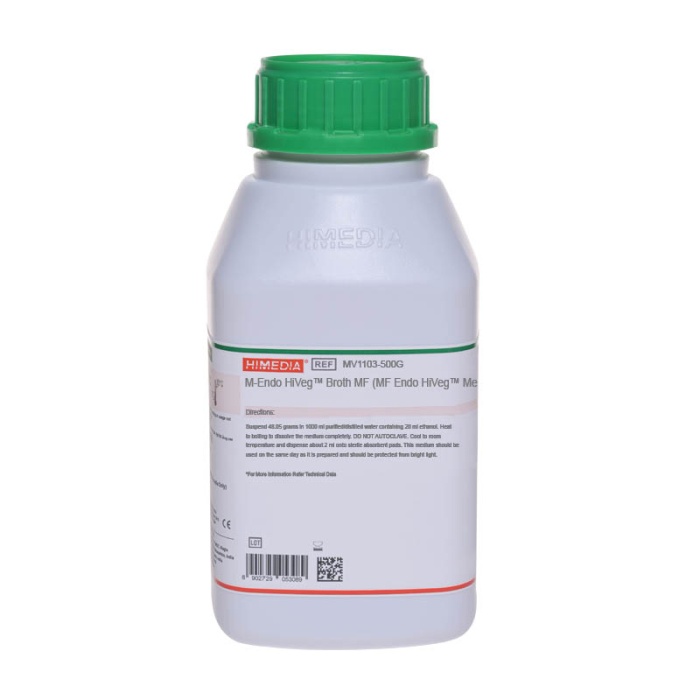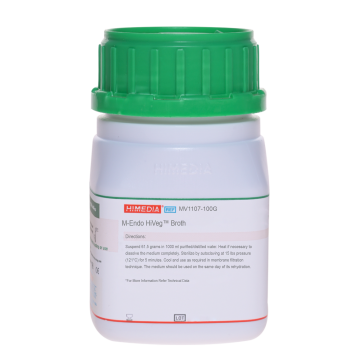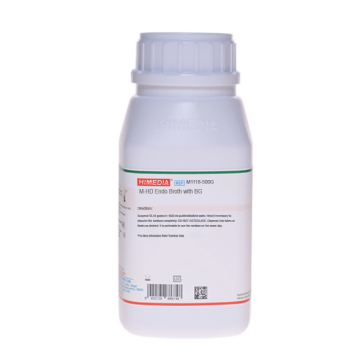 Your enquiry has been submitted
Your enquiry has been submitted
M-Endo Broth
Intended Use
Recommended for estimation of coliforms in water samples using membrane filtration technique.
Composition**
| Ingredients | Gms/Litre |
|---|---|
| Peptone | 20.000 |
| Yeast extract | 6.000 |
| Lactose | 25.000 |
| Dipotassium hydrogen phosphate | 7.000 |
| Basic fuchsin | 1.000 |
| Sodium sulphite | 2.500 |
| Final pH (at 25°C) | 7.5±0.2 |
**Formula adjusted, standardized to suit performance parameters
Directions
Suspend 61.5 grams in 1000 ml purified / distilled water. Heat if necessary to dissolve the medium completely. Sterilize by autoclaving at 15 lbspressure (121°C) for 5 minutes. Cool to 45-50°C and use as required in membrane filtration technique. The medium should be used on the same day of its rehydration.
Caution: Basic fuchsin is a potential carcinogen and care should be taken to avoid inhalation of the powdered dye and contamination of the skin.
Principle And Interpretation
It is possible to remove bacteria from fluids by passing them through filters with such small pore size that bacteria are arrested. This filtration technique enables fairly large volumes of water to pass rapidly under pressure, but prevents the passage of any bacteria present. These nutrients are retained on the surface of the membrane which is then brought into contact with suitable liquid nutrients. These diffuse upwards through the pores thereby inducing the organisms to grow as surface colonies which can be counted (1). M-Endo Broth was used for studying milk lines of milk handling equipment (2) and for examination of swimming pool waters (3) using membrane filter technique. This medium gives higher counts and is most satisfactory of the many media used, since coliform colonies develop rapidly (4), preliminary enrichment and saturated relative humidity are not necessary and results are in good agreement with the Standard Methods MPN Test.
Peptone and yeast extract provide essential nutrients especially nitrogenous and carbonaceous copounds, long chain amino acids and other essential nutrients for the coliforms. Lactose is the fermentable carbohydrate. Sodium sulphite and basic fuchsin inhibit the growth of gram-positive organisms. Phosphates buffer the medium. Coliforms ferment lactose and the resulting acetaldehyde reacts with sodium sulphite and basic fuchsin to form red colonies and similar colouration of the medium. Lactose non-fermenters form colourless colonies.
Type of specimen
Water samples
Specimen Collection and Handling:
For water samples, follow appropriate techniques for sample collection, processing as per guidelines and local standards (5). After use, contaminated materials must be sterilized by autoclaving before discarding.
Warning and Precautions
Read the label before opening the container. Wear protective gloves/protective clothing/eye protection/ face protection. Follow good microbiological lab practices while handling specimens and culture. Standard precautions as per established guidelines should be followed while handling specimens. Safety guidelines may be referred in individual safety data sheets.
Limitations
- Due to varying nutritional requirements, some strains may be encountered that grow poorly.
- If the inoculum is too heavy, the sheen may be suppressed.
- Occasionally, noncoliform organisms may produce typical sheen colonies. Coliform organisms may also occasionally produce atypical colonies, including dark red or nucleated colonies without sheen.
- Further serological and biochemical testing is necessary for complete identification.
Performance and Evaluation
Performance of the medium is expected when used as per the direction on the label within the expiry period when stored at recommended temperature.
Quality Control
Appearance: Light pink to purple homogeneous free flowing powder
Colour and Clarity of prepared medium: Pinkish orange coloured opalescent solution in tubes
Reaction: Reaction of 6.15% w/v aqueous solution at 25°C. pH: 7.5±0.2
pH: 7.30-7.70
Cultural Response
Cultural characteristics observed after an incubation at 35-37°C for 18-48 hours.
| Organism | Inoculum (CFU) | Growth | Colour of colony (on membrane filter) |
|---|---|---|---|
| Escherichia coli ATCC 25922 (00013*) | 50-100 | good-luxuriant | pink with metallic sheen |
| # Klebsiella aerogenes ATCC 13048 (00175*) | 50-100 | good-luxuriant | pink to red (may have sheen) |
| Salmonella Typhi ATCC 6539 | 50-100 | luxuriant | colourless to very light pink |
| Staphylococcus aureus subsp. aureus ATCC 25923 (00034*) | >=104 | inhibited | |
| Klebsiella pneumoniae ATCC 13883 (00097*) | 50-100 | good-luxuriant | pink to red |
| Salmonella Typhimurium ATCC 14028 (00031*) | 50-100 | luxuriant | colourless to very light pink |
Key: (*) Corresponding WDCM numbers. (#) Formerly known as Enterobacter aerogenes
Storage and Shelf Life
Store between 10-30°C in a tightly closed container and the prepared medium at 15-30°C. Use before expiry date on the label. On opening, product should be properly stored dry, after tightly capping the bottle in order to prevent lump formation due to the hygroscopic nature of the product. Improper storage of the product may lead to lump formation. Store in dry ventilated area protected from extremes of temperature and sources of ignition Seal the container tightly after use. Product performance is best if used within stated expiry period.
Disposal
User must ensure safe disposal by autoclaving and/or incineration of used or unusable preparations of this product. Follow established laboratory procedures in disposing of infectious materials and material that comes into contact with sample must be decontaminated and disposed of in accordance with current laboratory techniques (6,7).
Reference
- Cruickshank R., Duguid J. P., Marmion B. P., Swain R. H. A., (Eds.), Medical Microbiology, 1975, 12th Ed. Vol. II, Churchill Livingstone.
- Olson, Brown and Mickle, 1960, J., Milk and Food Tech., 23:86.
- Shipe E. L. and Fields A., 1955, Public Health Lab., 13:44.
- Slanetz L. W. and Bartley C. H., 1955, Applied Microbiol., 3:46.
- Lipps WC, Braun-Howland EB, Baxter TE,eds. Standard methods for the Examination of Water and Wastewater, 24th ed. Washington DC:APHA Press; 2023.
- senberg, H.D. Clinical Microbiology Procedures Handbook 2nd Edition.
- Jorgensen, J.H., Pfaller, M.A., Carroll, K.C., Funke, G., Landry, M.L., Richter, S.S and Warnock., D.W. (2015) Manual of Clinical Microbiology, 11th Edition. Vol. 1.
| Product Name | M-Endo Broth |
|---|---|
| SKU | M1107 |
| Product Type | Regular |
| Physical Form | Powder |
| Origin | Animal |
| Packaging type | HDPE |
| References | 1. Cruickshank R., Duguid J. P., Marmion B. P., Swain R. H. A., (Eds.), Medical Microbiology, 1975, 12th Ed. Vol. II, ChurchillLivingstone2.Olson, Brown and Mickle, 1960, J., Milk and Food Tech., 23:86.3.Shipe E. L. and Fields A., 1955, Public Health Lab., 13:44.4.Slanetz L. W. and Bartley C. H., 1955, Applied Microbiol., 3:46. |
| Customized Product Available | No |










